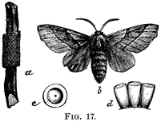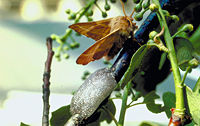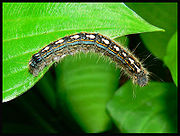
Forest tent caterpillar
Encyclopedia
The Forest Tent Caterpillar Moth (Malacosoma disstria) is the larva of a North America
n moth
, found throughout the United States
and Canada
, and most common in the eastern regions.
 These tent caterpillar
These tent caterpillar
s do not make tents, rather they weave a silky sheet where they lie together during molting
. They lay down strands of silk as they move over branches and travel along them like tightrope
walkers. However, it has been shown that a trail pheromone
secreted from the ventral surface of the posterior tip of the abdomen rather than the silk guides and stimulates trail following. The caterpillar are social and travel and feed en masse. The caterpillars live in deciduous
trees, which they strip of leaves after emerging from their eggs. The moths favor oak
, sweetgum and tupelo, aspen
trees, and sugar maple
for oviposition but the larvae can be found feeding on many other species of woody trees or shrubs when they disperse from ovipositional trees during outbreaks. The females lay eggs in masses of up to 300, which are stuck to twigs and covered with a gluey cement called spumaline which prevents them from desiccating or freezing over the winter. The eggs hatch the following winter.
 The caterpillars are considered a problem when their populations explode in the fall. They can completely consume a tree. The trees re-foliate quite quickly (within two weeks to a month) and produce enough new leaves to carry on photosynthesis
The caterpillars are considered a problem when their populations explode in the fall. They can completely consume a tree. The trees re-foliate quite quickly (within two weeks to a month) and produce enough new leaves to carry on photosynthesis
. Under most circumstances, little lasting damage is caused to the trees; however the disappearance of foliage is an eyesore and can be an agricultural
nuisance. On those rare occasions when infestations last for three years or more, significant levels of tree mortality will begin to emerge during the years following outbreak collapse. Large-scale tree mortality has been reported in only one instance, in northern Ontario
, Canada
, after two outbreak cycles in the early and late 1990s occurred back-to-back, resulting in more than six consecutive years of aspen
defoliation in some areas.
One outbreak in upstate New York and Vermont began in 2002, with 650,000 acres (2600 km²) defoliated in New York
and 230,000 acres (930 km²) in Vermont
in 2005.

It is not known with certainty how far egg-laden female moths tend to fly. There is one credible report of moths flying hundreds of kilometres with the assistance of an unusually strong wind.

(Malacosoma americanum), has been linked to a phenomenon called 'Mare Reproductive Loss Syndrome
' (MRLS). Experimental studies have shown that when pregnant mares are fed eastern tent caterpillars they abort. The caterpillars of this species often feed on the highly cyanogenic black cherry tree (Prunus serotina) and it was originally hypothesized that the mares were aborting in response to the cyanide they consumed along with the caterpillars. However, that hypothesis was disproven. In another study, the necropsy of a mare fed eastern tent caterpillars showed that fragments of the caterpillar's setae had embedded in the gut wall leading investigators to hypothesize that these invasive fragments may allow infective agents to pass into the animal's blood stream then travel to the placenta, initiating an abortive event. It remains to be determined whether this is indeed the cause of MRLS.
(flies) of the family Tachinidae
and Sarcophagidae.
. Caterpillars placed in non-soapy water can literally crawl across the surface to escape.) Dusk is a good time to attack caterpillars as they are gregarious and form dense groups on tree trunks and structures at the end of the day.
North America
North America is a continent wholly within the Northern Hemisphere and almost wholly within the Western Hemisphere. It is also considered a northern subcontinent of the Americas...
n moth
Moth
A moth is an insect closely related to the butterfly, both being of the order Lepidoptera. Moths form the majority of this order; there are thought to be 150,000 to 250,000 different species of moth , with thousands of species yet to be described...
, found throughout the United States
United States
The United States of America is a federal constitutional republic comprising fifty states and a federal district...
and Canada
Canada
Canada is a North American country consisting of ten provinces and three territories. Located in the northern part of the continent, it extends from the Atlantic Ocean in the east to the Pacific Ocean in the west, and northward into the Arctic Ocean...
, and most common in the eastern regions.

Tent caterpillar
Tent caterpillars are moderately sized species in the genus Malacosoma and in the moth family Lasiocampidae. Species occur in North America, Mexico, and Eurasia. Twenty-six species have been described, six of which occur in North America. Some species are considered to have subspecies as well. ...
s do not make tents, rather they weave a silky sheet where they lie together during molting
Ecdysis
Ecdysis is the moulting of the cuticula in many invertebrates. This process of moulting is the defining feature of the clade Ecdysozoa, comprising the arthropods, nematodes, velvet worms, horsehair worms, rotifers, tardigrades and Cephalorhyncha...
. They lay down strands of silk as they move over branches and travel along them like tightrope
Tightrope walking
Tightrope walking is the art of walking along a thin wire or rope, usually at a great height. One or more artists performs in front of an audience or as a publicity stunt...
walkers. However, it has been shown that a trail pheromone
Pheromone
A pheromone is a secreted or excreted chemical factor that triggers a social response in members of the same species. Pheromones are chemicals capable of acting outside the body of the secreting individual to impact the behavior of the receiving individual...
secreted from the ventral surface of the posterior tip of the abdomen rather than the silk guides and stimulates trail following. The caterpillar are social and travel and feed en masse. The caterpillars live in deciduous
Deciduous
Deciduous means "falling off at maturity" or "tending to fall off", and is typically used in reference to trees or shrubs that lose their leaves seasonally, and to the shedding of other plant structures such as petals after flowering or fruit when ripe...
trees, which they strip of leaves after emerging from their eggs. The moths favor oak
Oak
An oak is a tree or shrub in the genus Quercus , of which about 600 species exist. "Oak" may also appear in the names of species in related genera, notably Lithocarpus...
, sweetgum and tupelo, aspen
Aspen
Populus section Populus, of the Populus genus, includes the aspen trees and the white poplar Populus alba. The five typical aspens are all native to cold regions with cool summers, in the north of the Northern Hemisphere, extending south at high altitudes in the mountains. The White Poplar, by...
trees, and sugar maple
Sugar Maple
Acer saccharum is a species of maple native to the hardwood forests of northeastern North America, from Nova Scotia west to southern Ontario, and south to Georgia and Texas...
for oviposition but the larvae can be found feeding on many other species of woody trees or shrubs when they disperse from ovipositional trees during outbreaks. The females lay eggs in masses of up to 300, which are stuck to twigs and covered with a gluey cement called spumaline which prevents them from desiccating or freezing over the winter. The eggs hatch the following winter.
Outbreaks

Photosynthesis
Photosynthesis is a chemical process that converts carbon dioxide into organic compounds, especially sugars, using the energy from sunlight. Photosynthesis occurs in plants, algae, and many species of bacteria, but not in archaea. Photosynthetic organisms are called photoautotrophs, since they can...
. Under most circumstances, little lasting damage is caused to the trees; however the disappearance of foliage is an eyesore and can be an agricultural
Agriculture
Agriculture is the cultivation of animals, plants, fungi and other life forms for food, fiber, and other products used to sustain life. Agriculture was the key implement in the rise of sedentary human civilization, whereby farming of domesticated species created food surpluses that nurtured the...
nuisance. On those rare occasions when infestations last for three years or more, significant levels of tree mortality will begin to emerge during the years following outbreak collapse. Large-scale tree mortality has been reported in only one instance, in northern Ontario
Ontario
Ontario is a province of Canada, located in east-central Canada. It is Canada's most populous province and second largest in total area. It is home to the nation's most populous city, Toronto, and the nation's capital, Ottawa....
, Canada
Canada
Canada is a North American country consisting of ten provinces and three territories. Located in the northern part of the continent, it extends from the Atlantic Ocean in the east to the Pacific Ocean in the west, and northward into the Arctic Ocean...
, after two outbreak cycles in the early and late 1990s occurred back-to-back, resulting in more than six consecutive years of aspen
Aspen
Populus section Populus, of the Populus genus, includes the aspen trees and the white poplar Populus alba. The five typical aspens are all native to cold regions with cool summers, in the north of the Northern Hemisphere, extending south at high altitudes in the mountains. The White Poplar, by...
defoliation in some areas.
One outbreak in upstate New York and Vermont began in 2002, with 650,000 acres (2600 km²) defoliated in New York
New York
New York is a state in the Northeastern region of the United States. It is the nation's third most populous state. New York is bordered by New Jersey and Pennsylvania to the south, and by Connecticut, Massachusetts and Vermont to the east...
and 230,000 acres (930 km²) in Vermont
Vermont
Vermont is a state in the New England region of the northeastern United States of America. The state ranks 43rd in land area, , and 45th in total area. Its population according to the 2010 census, 630,337, is the second smallest in the country, larger only than Wyoming. It is the only New England...
in 2005.

Appearance
Forest tent caterpillars are just over 2 inches (5 cm) in length, although some have been reported to grow to 4 or 5 inches as well, black or dark brown or gray with blue and faint yellow longitudinal stripes. Each abdominal segment bears a white spot. The caterpillars have long setae, giving them a furry look. The adult moth that emerges after pupation is yellow or tan with a thick, short, furry body. The wingspan is about 1.5 inches (3 cm). It is rather strictly nocturnal, starting to fly soon after nightfall and by and by returning to rest in the latter half of the night (Fullard & Napoleone 2001).It is not known with certainty how far egg-laden female moths tend to fly. There is one credible report of moths flying hundreds of kilometres with the assistance of an unusually strong wind.

Toxicity
A closely related species, the eastern tent caterpillarEastern tent caterpillar
The Eastern tent caterpillar is a univoltine, social species that forms communal nests in the branches of trees. It is sometimes confused with the gypsy moth, or the fall webworm and may be erroneously referred to as a bagworm which is the common name applied to unrelated caterpillars in the...
(Malacosoma americanum), has been linked to a phenomenon called 'Mare Reproductive Loss Syndrome
Mare Reproductive Loss Syndrome
Mare Reproductive Loss Syndrome has been diagnosed in mares of all breeds and ages. It was initially observed in Kentucky in a three week period around the first of May, 2001, when about 20% to 30% of Kentucky's pregnant mares suffered abortions...
' (MRLS). Experimental studies have shown that when pregnant mares are fed eastern tent caterpillars they abort. The caterpillars of this species often feed on the highly cyanogenic black cherry tree (Prunus serotina) and it was originally hypothesized that the mares were aborting in response to the cyanide they consumed along with the caterpillars. However, that hypothesis was disproven. In another study, the necropsy of a mare fed eastern tent caterpillars showed that fragments of the caterpillar's setae had embedded in the gut wall leading investigators to hypothesize that these invasive fragments may allow infective agents to pass into the animal's blood stream then travel to the placenta, initiating an abortive event. It remains to be determined whether this is indeed the cause of MRLS.
Outbreak cycles
Forest tent caterpillar outbreaks tend to recur at reasonably regular intervals every decade or so, with the precise interval varying somewhat in time and space. Outbreaks usually last two to four years. Although the insect's distributional range is quite large, the area over which decadal outbreak cycles are synchronized (i.e. oscillating with the same phase) varies substantially. Outbreak cycles are more strongly synchronized in eastern Canada than in western Canada. Where spatially separated populations are phase-synchronized, the synchronization is thought to be due to the process of entrainment, that is the synchronization of a circadian clock with the external environment.Mortality agents
The cause of the outbreak cycle is not known with certainty. There are a large number of natural mortality agents which could be responsible for population cycling - including, but not limited to: parasitoids, predators, starvation, disease, and severe spring, summer, or winter weather. Most infestations subside after one or two years, as a result of a combination of these factors. The most common parasitoids associated with population decline are DipteraDiptera
Diptera , or true flies, is the order of insects possessing only a single pair of wings on the mesothorax; the metathorax bears a pair of drumstick like structures called the halteres, the remnants of the hind wings. It is a large order, containing an estimated 240,000 species, although under half...
(flies) of the family Tachinidae
Tachinidae
Tachinidae is a large and rather variable family of true flies within the insect order Diptera, with more than 8,200 known species and many more to be discovered. There are over 1300 species in North America. Insects in this family are commonly called tachina flies or simply tachinids...
and Sarcophagidae.
Control measures
Larvacides applied in early spring can be effective, but once the caterpillars emerge little can be done. They can be removed from trees by hand and killed by dropping them into a bucket of soapy water. (The soap reduces the water's surface tensionSurface tension
Surface tension is a property of the surface of a liquid that allows it to resist an external force. It is revealed, for example, in floating of some objects on the surface of water, even though they are denser than water, and in the ability of some insects to run on the water surface...
. Caterpillars placed in non-soapy water can literally crawl across the surface to escape.) Dusk is a good time to attack caterpillars as they are gregarious and form dense groups on tree trunks and structures at the end of the day.
External links
- Terrence D. Fitzgerald: Forest Tent Caterpillar
- forest tent caterpillar on the UFUniversity of FloridaThe University of Florida is an American public land-grant, sea-grant, and space-grant research university located on a campus in Gainesville, Florida. The university traces its historical origins to 1853, and has operated continuously on its present Gainesville campus since September 1906...
/ IFASInstitute of Food and Agricultural SciencesThe University of Florida’s Institute of Food and Agricultural Sciences is a federal-state-county partnership dedicated to developing knowledge in agriculture, human and natural resources, and the life sciences, and enhancing and sustaining the quality of human life by making that information...
Featured Creatures Web site

